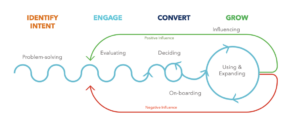When most people think about influencer marketing, the first examples that come to mind are B2C, but it’s at least equally effective in B2B. It should also be a key consideration in your ABX strategy. In this post, we will go into how to determine how customers are talking about you and how to turn them into positive influencers.

Your customers are important influencers in your pipeline of prospective new customers. They can be a positive or a negative influence.
The reason why your current customers are especially important in influencer marketing is that people trust other people more than any other channel. According to Nielsen’s Global Trust in Advertising report (2021), 89% of people globally trust recommendations from friends and family. This is the most trusted channel.
Interestingly, branded websites are the second most trusted channel. This reinforces why sharing customer testimonials on your website and other forms of social proof should be a high priority.
In developing a buyer journey-driven marketing strategy, you should assume that buyers will talk to peers and actively seek their opinions as they consider solutions. They will also rely on sources of reviews and ratings. This may include analysts, rating websites, and any public source of customer reviews.
Ignore this at your peril!
Companies who have mastered influencer marketing use it to build trust and turn trust into committed relationships.
Identifying Positive Influencers and Detractors
The foundation of influencer marketing with your customers is to understand what your customers are saying about you or not saying about you. There are several ways to assess this.
Social Media Listening Programs
Many services allow you to monitor what people are saying about you online. Services like Sprout Social and Meltwater enable you to analyze sentiments about your brand. You can determine what positive things are being said, what are the negative topics, and what s being said about you versus your competitors.
It’s essential to determine the strongest influencers, especially if they are customers. Most importantly, try to analyze comments by customers.
Comparison sites
One of the more structured forms of social influence is comparison and rating sites. Sites like G2, Capterra, and Softwareadvice.com make it easy for buyers to compare solutions based on customer ratings.
It is easy to have your site rated, and these are also good channels for digital marketing.
Analysts Talk to Both Positive Influencers and Detractors
B2B firms have love/hate relationships with market analysts. To some, you must pay for an expensive subscription to be covered. Analyst firms like Gartner are held in high regard by B2B buyers. Ignore them at your cost.
In the context of ABX, the most critical analysts base their perspectives entirely on customer interviews. For example, in healthcare technology, the analyst firm KLAS surveys vendors’ customers to create market analyses on different sectors within healthcare. Buyers value their reports as they analyze how their peers are addressing similar issues and how they rate various vendors.
As a vendor, these are important in gauging how you compare to your competitors and understanding what our customers and prospects value as important. It can also help provide ideas and prioritization advice on what to consider in your product roadmap.
Intent Data
As we covered in this post, use intent data with your current customers to understand what other solutions they are evaluating and to determine who is at risk of defecting.
Strategies to Create More Positive Influencers
So how do you use the intelligence about how your customers influence your prospects? Here are several strategies to consider.
The Basics
Several things should be considered “basic hygiene” in marketing:
- Logos as social proof— As you have no doubt noticed, most B2B websites feature the logos of their customers prominently. These are important because when a buyer visits your website, one of their first questions is “Do they have customers like me?”
- Testimonials–These extend basic social proof into showing how committed your customers are and provide clear examples of working with you.
- Case studies are especially helpful to buyers later in the buyer journey. They are important for your champion prospects as they provide substantial detail on what to expect. Champions use these case studies with their buyer committees. These are also great PR ammunition. Trade publications love to write detailed stories about how a company in their market has solved a problem. Your case studies make that easier for them to do this.
- References—Later in the buying process, prospects will ask to speak to references they can interview privately about why they should select you. It’s best to have a large pool of those who are ready to go. You don’t want to depend on a few customers who may begrudge you for asking them too often.
Turning Positive Influencers Into Customer Champions
Customers will become even more enthusiastic about you when you celebrate them. There are so many ways to do that. These will require sales and marketing to partner with the customer success team.
Start by identifying your most committed customers and design a customer champion program around them. This will include several different strategies.
Celebrate their wins by reposting and tagging when your customers are featured in the press or in social media. This shows you care about them and their success. It also associates you with their success.
Secondly, make them proud to be your customer by giving them advanced notice when good news is about to break, for example, winning an award, making a major hire, or closing a funding round. Giving them a warning increases the likelihood of sharing this on social media.
When you write a post on LinkedIn or Twitter about a customer, for example, sharing a case study, tag the company and your customers. This will expose your post to their network and extend the reach of your social media post.
Celebrating them will make your most committed and enthusiastic supporters more open to advocating for you. As they have egos and are ambitious about their careers, many will be open to being featured in the media on your behalf. Create a campaign around them that will feature them speaking about you in press stories, webinars, social media posts, testimonial videos, and speaking on conference panels that you host.
If you can afford it, host an annual customer event where you can invite both customers and prospects. Celebrate your customers at this event, and tell their stories to demonstrate your solutions’ impact. Introduce them in person to prospects. They can’t help by evangelizing what you do in a setting like this. Lastly, encourage and make it easy for them to post about the event on social media.
These events are also important in converting neutral and negatively disposed customers. For customers who seem satisfied but not committed, these events are an opportunity to showcase the value of what you do and expose them to benefits they may not know about. For at-risk customers, it may be an opportunity to give them special attention and a forum for senior executives to hear their concerns.
Educating Your Customers
So much of the content that is created in B2B marketing is geared toward new customer acquisition. Your existing customers are a critical audience. Seeing you as an authority will make them value you more. Thought leadership content that reinforces your knowledge and insight will educate them and reinforce that they made a good decision.
It also gives them content to share on social media and to pass along to their peers. You can make this even more effective by having them contribute to this content.
Invite Positive Influencers into your product development process
One of the best things you can do to turn customers into evangelists is to include them formally in your product development process. Customer and User Advisory Boards are a good mechanism for this. These are a good way for your product development leaders to hear directly from customers about what they would like included.
One key thing to remember is that as you deploy new features, publicly acknowledge their input and give them advance notice of updates. Remind them that they contributed to this. Tag them with thanks in social media posts announcing launches. This will increase the reach and likelihood of your posts being shared by them.
Neutralizing Negative News
Bad news travels faster than good news. So, when a customer complains about you online, you must immediately jump on it! This is one of the reasons it is so important to have a social listening team in place. The key thing is to have a procedure to address this.
You can’t do anything to reverse a legitimate negative post, but you may be able to stop additional ones. Marketing and customer success will need to work closely together.
The first thing to do is for customer success to acknowledge to the customer that you take their concern seriously and offer to address the issue as fast as possible. Organize a team to meet with them quickly, including a senior executive and other executives who can help resolve this issue. Then put a remediation plan in place.
This will put you on track to solve the issue and will likely dissuade them from posting negative comments about you while resolving the issue.
Using influencer marketing and relationship-building strategies is a key part of your long-term growth strategies. In an ABX program, they are one of the most powerful tools in your arsenal to influence future sales with new customers.
Photo by Franco Antonio Giovanella on Unsplash
Originally posted on LinkedIn.

